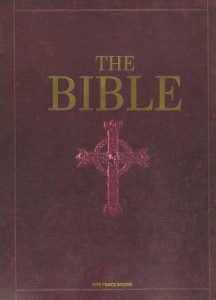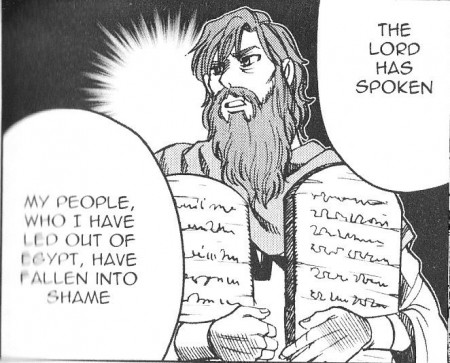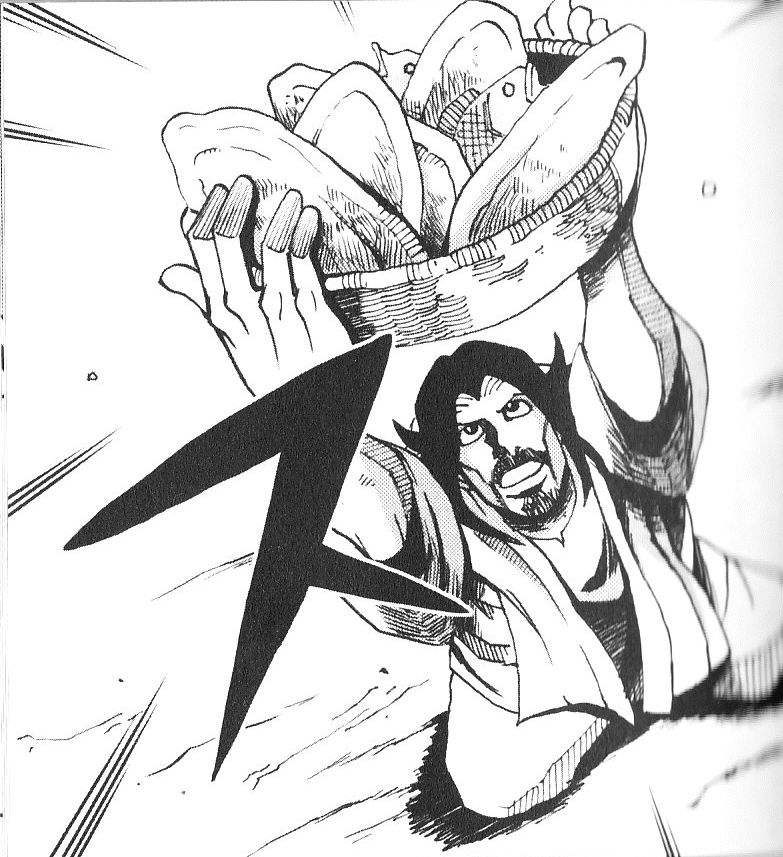The Bible Manga Review
Arguably no assemblage of thought, no written collection of ideas, has influenced and impacted the earth and human civilization more than The Bible. Scripture has provided guidance and moral authority for countless adherents for over two millennia. Yet The Bible is also an evocative fantasy, as unearthly and convoluted as the religious myths of the ancient Greeks. The Bible is filled with spirits, demons, magic, murder, betrayal, war and bloody conflict, sex and lust. The Bible is an epic adventure, which explains why it remains so iconic and inspiring even to people that are not devout believers. Since The Bible, in fact, contains many of the same fantastic narrative elements that commonly appear in Japanese manga, it should be little surprise that manga adaptations of The Bible have been created. One Peace Books has brought one of those adaptations to English speaking readers, to mixed benefit.
One Peace Books’ The Bible is a hefty 576 page softcover that combines the Old Testament and New Testament manga originally published in Japan in 2010 as separate books by publisher Variety Art Works. The English language publication consists of 13 Old Testament stories plus an original epilogue that summarizes the Old Testament and introduces the New, and and eight chapter summary of the New Testament that focuses primarily on the life, death, and resurrection of Christ. The Old and New Testaments were obviously drawn by two different artists, both anonymous in the English and original Japanese publications. The visual art for the Old Testament adaptation is regocnizably manga, making full use of speed lines, screen tone, dynamic panel organization, and visual sound effects. The art design uses a mildly soft linework, somewhat light on detail, reminiscent of stereotypical “Ameri-manga.” The art is servicable and may be easily accessible for readers unfamiliar with Japanese manga or readers that dislike the more distinctively Japanese design of typical manga. The artwork of the New Testament is superficially similar but reveals a more angular, more simplified and exaggerated drafting style reminiscent of American black & white indie comics from the late 1980s and early 90s. Once again, the art may not appeal to veteran manga readers used to particular visual styles, but it is effective at conveying its meaning and may be especially accessible for novice manga readers. Visual sound effects are unaltered but not translated. Manga veterans may appreciate One Peace Book’s respect for the integrity of the original art, but readers unfamiliar with manga may find the odd, crypic, foreign symbols confusing or distracting since they’re not explained or translated. The book’s print quality is crisp; screen tone shading consistently looks clean rather than muddy, hazy, or out of focus.
The Old Testament is a faithful, albeit cursory, adaptation of The Bible. The presentation uses a hybrid of narration and spoken dialogue. The narration perodically quotes scripture but is more frequently objective summary. The translated dialogue is periodically almost humorously contemporary, but it fits the adaptation well. The primary weakness of The Bible manga is the brevity of the Old Testament adaptation. Most of the chapters are rather short, and events are presented with baffling concision. Sodom and Gomorrah are never clearly identified as cities. Exactly what Esau’s birthright was goes unexplained. Rebekah’s participation in the deception of Esau is entirely excluded. Jacob being betrayed himself after betraying his brother is entirely excluded. The reason why Moses & Aaron are not allowed to enter the promised land is not explained. The significance of Saul coming from the tribe of Benjamin is never explained. Tribes and factions including the Moabites, Ammonites, Midians, Amalekites, Philistines, and Levittes are mentioned but never explained, which may leave novice readers confused. Readers that are not intimately familiar with The Bible may find themselves frequently scratching their heads while reading The Bible manga because the adaptation skims over and leaves out so much information, a regrettable necessity given the dense narrative detail of The Bible.
While The Old Testament chapters of The Bible manga are a literal adaptation of The Bible, the New Testament comes across like an illustrated critical summary, beginning with an objective explanation that The New Testament was composed from 1,500 to 1,000 BC. Similarly, the narration breaks the fourth wall by providing commentary on critical interpretations for the motivation behind Judas Iscariot’s betrayal of Jesus. The New Testament adaptation illustrates Jesus Christ’s birth, life, death, and resurrection in seven substantial chapters. The book then provides a cursory final chapter that summarizes Acts and Revelations, taking care to academically explain that John composed the Book of Revelations from 90 to 95 AD on the island of Patmos.
Unlike publisher Doubleday’s 2007 The Manga Bible, which, strictly speaking, isn’t manga at all, One Peace Books’ The Bible is an authentic manga adaptation of scripture. However, the books suffers with a vague target demographic. Devout followers will likely find The Bible manga too heavily abridged to be fully satisfying. Novice readers will be left confused by situations and scenarios presented without sufficient context, and references made without explanation. On a side note, the absence of page numbers in the book also makes quickly locating specific chapters needlessly difficult. Fans of atypical manga should certainly add The Bible to their library to compliment One Peace Books’ growing catalog of unusual, exceptional English translations of Japanese manga. Religious institutions and religious teachers are sure to find The Bible manga invaluable for introducing The Bible and scripture to younger readers and readers intimidated by or disinclined to crack open a conventional Bible. However, unfortunately, many of the readers who may seem to be the ideal and intended audience for this manga are likely to find it not comprehensive enough to be completely satisfying.
Add a Comment
You must be logged in to post a comment.





Ah, the Doubleday “Manga” Bible. Looking at these panels, that book should have looked like this. The artwork was really bad. Still, we got to see Jesus give an arogant smirk before telling everyone “he who is without sin, cast the first stone,” so it wasn’t a complete loss.